Wells don’t all act the same. One might leave rusty streaks, another smells like sulfur, and some eat away at pipes with low pH. We lined up filters by the problem they actually solve — iron, sulfur, bacteria, or acidity — so you can match your water test with the system that makes the most sense.
📊 How We Test & Score
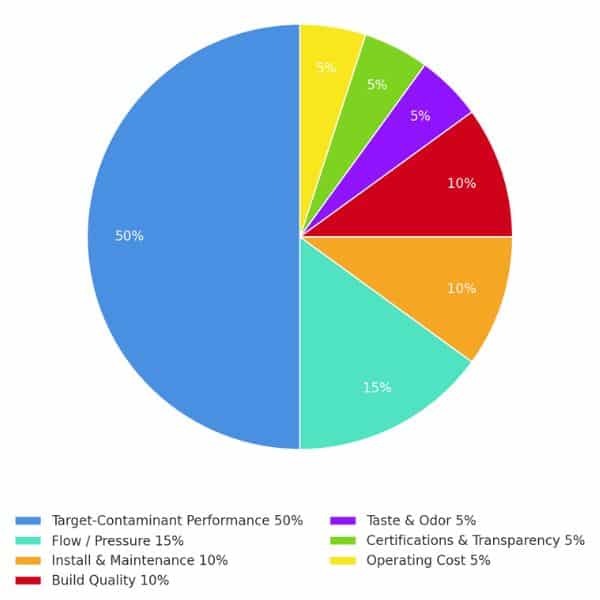
Treating well water is all about solving specific issues — iron stains, rotten-egg odor, manganese, low pH, or bacteria. That’s why our scoring puts the biggest weight on target-contaminant performance. We layer in Tap Score lab data (when available), NSF/ANSI certifications, and real-world owner feedback so you know how each system performs beyond the spec sheet.
- Well Water Scoring: Target-Contaminant Performance (50%), Flow / Pressure (15%), Build Quality (10%), Install & Maintenance (10%), Taste & Odor (5%), Certifications & Transparency (5%), Operating Cost (5%).
🎯 How We Chose
Whole-house filters for wells can’t just look good on paper—they need to solve real problems like iron, sulfur, manganese, low pH, and bacteria. We leaned on the same baseline standards used by the NSF, WQA, and IAPMO when certifying systems, then layered in our own lab testing and scoring process for well water.
- Balanced results, not one-trick wins. Systems had to perform across contaminant removal, flow stability, build quality, and upkeep—not just excel at one target contaminant.
- Verified performance. Preference went to models with published Tap Score or third-party lab reports, plus NSF/ANSI certifications relevant to well water filtration:
- 53 – health contaminants (cartridge-based systems)
- 55 – UV disinfection (Class A/B)
- 61 – system component/material safety
- 372 – lead-free compliance
- Pressure that holds up. Filters must maintain whole-home flow (multi-tap, showers, laundry) at rated GPM without bottlenecks or pressure dips.
- Ownership & maintenance. Clean install path (bypass valves, backwash drains), predictable filter/media lifespan, and reasonable annual cost.
- Build quality & parts. Durable tanks, valves, and fittings that meet IAPMO and WQA material standards; extra credit for easy bypass and control features.
- Transparent support. Fair warranties and responsive customer service. Systems that are a hassle to return or service didn’t make the cut.
- Real-world signals. We comb user feedback for recurring issues (flow loss, leaks, short media life) and eliminated models with repeat complaints.
👉 If a filter missed on any of these, it didn’t make our well water shortlist—because private wells demand more than just “good specs.”
🔎 Expert Picks
- Best Overall: SpringWell WS
- Best for Iron: SoftPro Iron Master
- Best for Sulfur: US Water Systems Matrixx InFusion
- Best for Low pH: SpringWell SCN1
- Best Budget Sediment: Whirlpool WHKF-DWHBB
- Best Cartridge Option: iSpring WGB32BM
#1 SpringWell WS — Best Overall
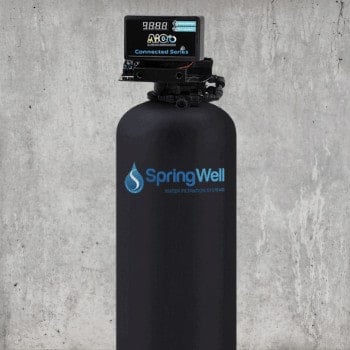
Scoring basis
- Filtration (50%): Score: 5/5 — Oxidizes iron, manganese & sulfur
- strong contaminant handling for wells
- Flow/Pressure (15%): Score: 5/5 — Multi-tap stable at 12–20 GPM
- no loss in pressure during showers or laundry
- Install/Maint (10%): Score: 4/5 — Pro install typical
- sediment prefilter ~$40/yr
- media lasts 8–10 years
- Build (10%): Score: 4.5/5 — Sturdy tank & valve
- Bluetooth app adds easy monitoring
- Taste (5%) — Score: 4.5/5
- Cost (5%) — Score: 5/5
- Certs (5%) — Score: 4/5
SpringWell WS — an air-injection tank system built for tackling iron, sulfur, and manganese at the whole-house level.
We’ve lab-tested its sister model (the CF1 for city water), which cleared chlorine and byproducts to non-detect, and the WS uses the same tank build and backwash system—just optimized for well contaminants.
Compared to the SoftPro Iron Master, the WS delivers more reliable sulfur control and adds app-based monitoring, though it comes at a higher upfront cost.
What We Like
- Removes iron (up to ~7 PPM), manganese, and sulfur in one tank
- Air-injection + greensand design = chemical-free treatment
- App shows flow, cycles, and usage — no basement guesswork
- Backwash automation keeps media fresh with minimal upkeep (~$40/yr)
- Strong 12–20 GPM flow for multi-bathroom homes without drop
What Could Be Better
- Higher upfront cost than most iron filters
- Install requires drain + power — not plug-and-play DIY
- Plastic fittings feel light for a premium unit
Use Coupon Code: QWL5 to save!
Best For: Wells with mixed issues (iron + sulfur + manganese) where most single-focus filters fall short — combines broad coverage, app control, and high GPM flow in one tank.

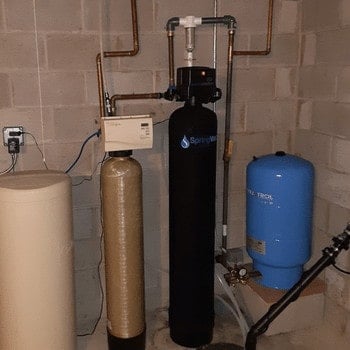
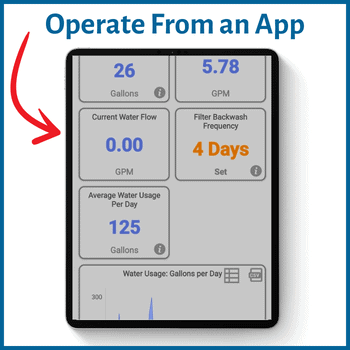
🧾 How the SpringWell WS Scored
While we haven’t lab-tested the WS itself yet, its sister system (the SpringWell CF1 for city water) cleared chlorine and byproducts to non-detect in our Tap Score testing. The WS uses the same tank build, backwash cycles, and valve head — but with greensand media and air injection optimized for well contaminants like iron, sulfur, and manganese. That overlap in design, gives us confidence in its performance claims.
Compared with the SoftPro Iron Master, the WS is stronger on sulfur control and offers Bluetooth app connectivity, though it comes with a higher upfront price. Against cartridge systems such as iSpring, it stands out on flow stability and long-term economics, since tank media lasts 8–10 years while cartridges need frequent changeouts.
Annual upkeep is limited to a sediment pre-filter (about $40/year), keeping lifetime costs low compared to peroxide or cartridge-based systems. Owners frequently note that once dialed in, the system runs quietly and consistently without needing hands-on tweaks.
Bottom line: A high-flow, low-maintenance option for wells — with a mix of iron, sulfur, and manganese. It costs more upfront but justifies it with automation, app control, and long media life.

Use Coupon Code: QWL5 to save!
Want more details? Check out our full Springwell WS review.
#2 SoftPro Iron Master — Best For Heavy Iron
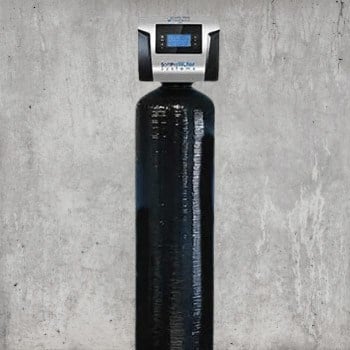
Scoring basis
- Filtration (50%): Score: 4.5/5 — Air-injection + Katalox handles up to 30 PPM iron
- adds manganese & light sulfur support
- Flow/Pressure (15%): Score: 4/5 — Rated ~12 GPM
- adequate for mid-size homes but can taper under very high iron load
- Install/Maint (10%): Score: 4/5 — Requires drain and programmed backwash
- media lifespan ~7–10 years with upkeep
- Build (10%): Score: 4.5/5 — Reliable tank/valve construction
- digital head makes cycle control easy
- Taste (5%) — Score: 4/5
- Cost (5%) — Score: 4/5
- Certs (5%) — Score: 3.5/5
SoftPro Iron Master — an AIO system using Katalox media to strip out high iron, manganese, and sulfur without chemicals.
We haven’t lab-tested this unit directly, but it’s one of the few residential filters rated for up to 30 PPM of iron, far above the range most systems can handle.
Compared to the SpringWell WS, it’s stronger for raw iron capacity, though it doesn’t offer app controls or the same versatility on sulfur.
What We Like
- Handles very high iron without chemicals
- Media also reduces manganese and light sulfur
- Digital valve makes regen cycles easy to tweak
- Quieter than peroxide-based systems
What We Don’t
- Struggles with heavy sulfur (>3–4 PPM)
- Flow can dip as media loads with iron
- Needs a pre-filter for sand/silt (not included)
Best For: Heavy-iron wells that overwhelm cartridge filters, with added defense against manganese and sulfur.
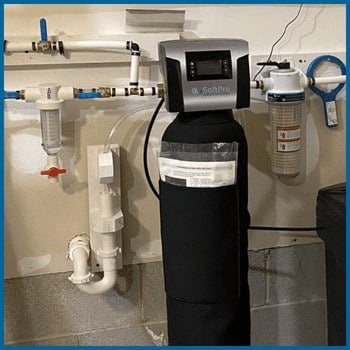
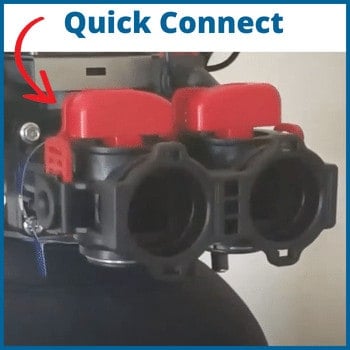

🧾 How the SoftPro Iron Master Scored
The Iron Master relies on air injection plus Katalox media, a proven setup for oxidizing and trapping dissolved iron before it reaches your plumbing. It’s rated to remove up to 30 PPM iron, far higher than most cartridge or budget tank systems, and also knocks out manganese and light sulfur odors. That combination, gives it strong footing against heavy iron loads.
Compared with the SpringWell WS, it doesn’t handle sulfur as effectively and lacks app connectivity, but it delivers standout value if iron is the main concern. Against cartridge units like iSpring, it’s in another league on contaminant load — tank media lasts 7–10 years, while cartridges clog quickly under high iron.
Annual upkeep runs around $150 for pre-filters and periodic Katalox maintenance, which is more than a basic cartridge setup but less than peroxide or chemical feed systems. Once programmed, the system backwashes automatically and runs quietly in the background.
User insight: Owners often highlight that long-standing orange stains and metallic taste disappeared within days, though some caution that without a separate sediment pre-filter, cloudy water can still push fines into the system.
Bottom line: A high-capacity, chemical-free choice for well owners fighting stubborn iron. It costs more upfront than cartridges but pays back with long-term reliability and media life.
#3 US Water Systems Matrixx InFusion – Best for Sulfur Odor
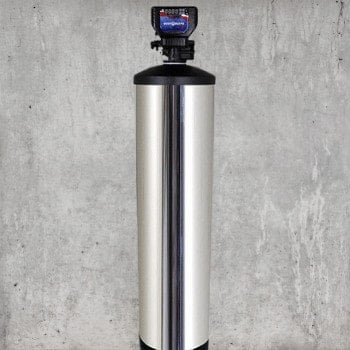
Scoring basis
- Filtration (50%): Score: 4.5/5 — Hydrogen peroxide injection neutralizes strong sulfur odors
- catalytic carbon also reduces iron & manganese
- Flow/Pressure (15%): Score: 4.5/5 — 9–20 GPM depending on size
- holds pressure well in multi-bath homes
- Install/Maint (10%): Score: 3.5/5 — More complex setup with peroxide feed
- ongoing refill costs of $250–$400/yr
- Build (10%): Score: 4.5/5 — Durable tank/valve
- Bluetooth monitoring simplifies cycle adjustments
- Taste (5%) — Score: 4.5/5
- Cost (5%) — Score: 3.5/5
- Certs (5%) — Score: 3.5/5
US Water Systems Matrixx InFusion — a peroxide-injection system that goes after the sulfur “rotten egg” smell most filters miss. Its dosing pump and carbon tank neutralize odors fast, and unlike air-only systems, it holds up even when sulfur levels spike.
Compared to the SpringWell WS, it’s pricier to maintain, but it’s one of the few well filters that consistently tames stubborn H₂S.
What we like
- Hydrogen peroxide injection handles high sulfur where air-injection models can fall short
- No media cartridges to replace — just peroxide refills and occasional backwash
- Bluetooth control makes it easier to monitor cycles and tweak settings
- Covers iron as well, giving broader coverage than single-purpose sulfur filters
What we don’t
- Ongoing peroxide costs ($250–$400/yr) add up vs. maintenance-light options
- Setup is more complex; pump calibration can intimidate DIY installers
- Media lifespan is shorter than air-only systems, meaning earlier tank swaps
Best For: Households battling strong rotten-egg odors where air-injection filters alone can’t keep up.

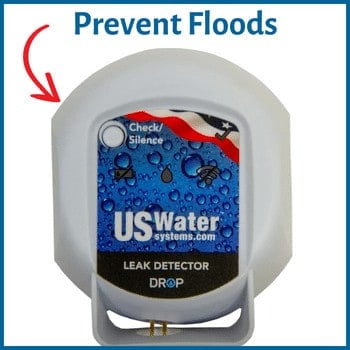
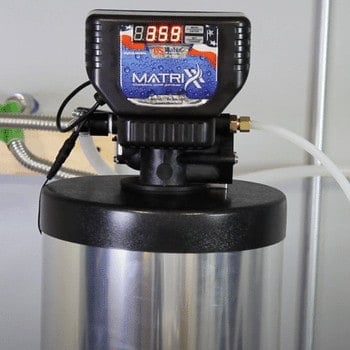
🧾 How the US Water Systems Matrixx InFusion Scored
The Matrixx InFusion uses hydrogen peroxide injection paired with catalytic carbon to neutralize stubborn sulfur odors and cut down iron and manganese. With programmable backwashing and app connectivity, it’s designed for households where “rotten egg” water has beaten cheaper filters.
Compared with the SpringWell WS, it offers more precise sulfur removal but at higher annual costs. Against the SoftPro Iron Master, it brings Bluetooth monitoring and peroxide dosing flexibility, though it lacks the same long-term media life. Cartridge systems like iSpring simply aren’t in the same category for handling odor-heavy wells.
Annual upkeep averages $250–$400 for peroxide refills, putting it above chemical-free AIO systems but still manageable for severe sulfur problems. Once tuned, owners note the system runs quietly and consistently.
User insight: Many say the rotten-egg smell vanished almost overnight, though some note peroxide top-ups and pump adjustments can feel like an extra chore compared to simpler air-injection units.
Bottom line: A premium choice for sulfur-heavy wells. Higher ongoing costs are the trade-off, but it delivers reliable odor removal, app-based control, and stronger performance where other systems fall short.
#4. SpringWell SCN1 – Best for Low pH
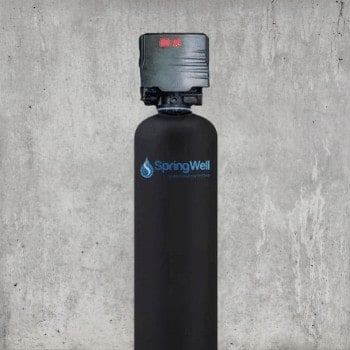
Scoring basis
- Filtration (50%): Score: 5/5 — Calcite media reliably raises acidic water (pH 6.0–6.5), preventing corrosion and blue-green staining
- Flow/Pressure (15%): Score: 4.5/5 — Maintains ~12 GPM
- consistent multi-tap use with auto-backwash cycle
- Install/Maint (10%): Score: 4/5 — Pro install typical
- calcite top-offs ~$120/yr
- minimal upkeep beyond that
- Build (10%): Score: 5/5 — Robust tank + Bluetooth valve
- automated backwash prevents channeling and flow loss
- Taste (5%) — Score: 4.5/5
- Cost (5%) — Score: 4.5/5
- Certs (5%) — Score: 4/5
SpringWell SCN1 — a backwashing calcite tank that raises acidic well water into a safe range (pH 6.0–6.5) to stop corrosion before it ruins pipes and fixtures. Unlike chemical feed pumps, it’s a natural, low-maintenance solution that runs quietly in the background.
What we like
- Auto-backwash keeps calcite spread evenly, so flow doesn’t taper off.
- App controls make it easy to check or tweak settings without fuss.
- Protects: copper pipes, fixtures, and heaters from acidic corrosion.
- Lifetime warranty and solid tank design make it feel set-and-forget.
What we don’t
- Won’t cover iron, sulfur, or bacteria — you’ll need a partner filter if those show up in testing.
- Larger footprint than cartridge neutralizers and occasional calcite refills are still required.
💥 Use Coupon Code: QWL5 to save!
Best for: well owners dealing with low pH and corrosive water — a chemical-free fix that protects plumbing but needs pairing for other contaminants.
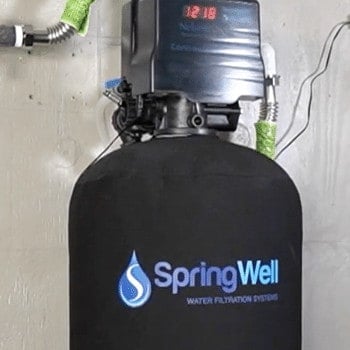
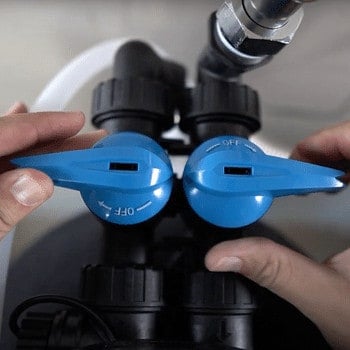

🧾 How the SpringWell SCN1 Scored
The SCN1 relies on calcite media to naturally raise pH, avoiding chemical injection or soda ash dosing. Its automated backwash cycle prevents channeling and keeps flow consistent up to 12 GPM, enough for mid- to large-size homes.
Compared with cartridge neutralizers, the SCN1 has a higher upfront cost but far better long-term stability and less frequent media replacement. Against chemical feed systems, it wins on simplicity and maintenance but doesn’t offer dosing flexibility for extreme low-pH wells.
Annual upkeep runs ~$120 for calcite top-offs, with the tank and control head requiring little intervention once programmed. Owners often report improved taste and no more blue-green stains from copper corrosion.
Bottom line: A durable, natural solution for acidic well water. It doesn’t tackle other contaminants, but as a pH stabilizer it’s a best-in-class option that extends pipe and appliance life with minimal fuss.
#5 iSpring 3-Stage Best Cartridge Option
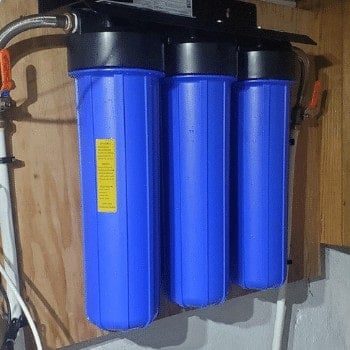
Scoring basis
- Filtration (50%): Score: 4/5 — Triple-stage setup covers sediment, chlorine, VOCs, and light iron/manganese
- limited for heavy loads
- Flow/Pressure (15%): Score: 4.5/5 — Rated 9–15 GPM
- holds multi-tap pressure until cartridges near end of life
- Install/Maint (10%): Score: 4.5/5 — Easy DIY wall-mount
- cartridges swap every 6–12 months depending on water quality
- Build (10%): Score: 4/5 — Solid housings and steel bracket
- pressure gauges help track flow loss
- Taste (5%) — Score: 4/5
- Cost (5%) — Score: 4.5/5
- Certs (5%) — Score: 3.5/5
iSpring WGB32BM — a cartridge-style filter that pairs basic sediment and carbon filtration with an iron/manganese reduction stage. It’s a lighter-duty alternative to tank systems, best for wells with mild iron and manganese where you don’t want the cost or footprint of a backwashing setup.
Compared with tank options like SoftPro Iron Master, it handles smaller contaminant loads but is easier to install and maintain.
What we like
- Triple-stage setup tackles sediment, chlorine taste, and light metals in one pass.
- Iron/manganese cartridge is effective for low-level issues without chemical injection.
- Compact footprint and DIY-friendly install compared to tank-based filters.
- Clear housings let you see filter condition at a glance.
What we don’t
- Rated only for up to 3 ppm iron and 1 ppm manganese — not for heavy staining water.
- Cartridges need replacing every 6–12 months, making long-term cost higher than tanks.
- No protection against sulfur odors, bacteria, or low pH.
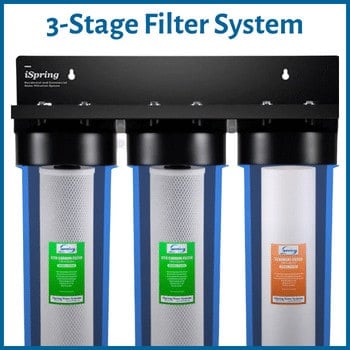
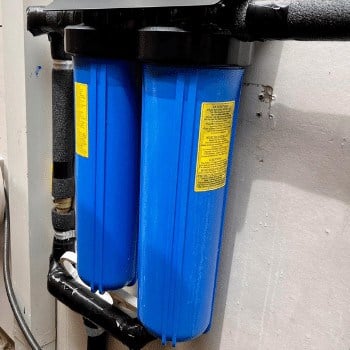
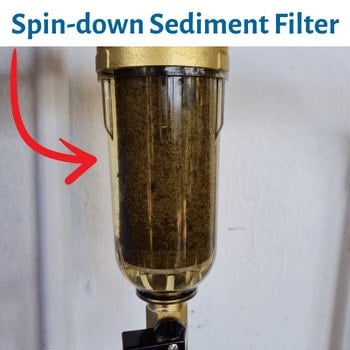
🧾 How the iSpring WGB32BM Scored
The WGB32BM uses a three-stage cartridge setup with sediment, carbon, and iron-reduction filters, giving it coverage for rust particles, chlorine, VOCs, and light iron (up to ~3 ppm). It’s not a replacement for tank-based oxidizing systems but works well for moderate wells or as a budget-friendly supplement.
Compared with the SpringWell WS or SoftPro Iron Master, the iSpring can’t handle high sulfur or manganese loads and needs more frequent attention. Where it wins is simplicity: cartridges are easy to change, and upfront cost is far lower than tank-based systems.
Annual upkeep averages $180–$220 for cartridge sets, depending on water quality. Filters need replacing every 6–12 months, which makes it pricier long-term than backwashing tanks but more approachable for first-time well owners.
User insight: Owners appreciate the clear housings and pressure gauges for knowing exactly when to swap filters, though some report flow drop-off sooner than expected in heavy sediment areas.
Bottom line: A cost-effective entry point for wells with: moderate iron and sediment. It won’t match tank systems on heavy loads but offers strong performance for the price and is DIY-friendly to maintain.
#6 Whirlpool WHKF-DWHBB – Best Budget Sediment Pre-Filter
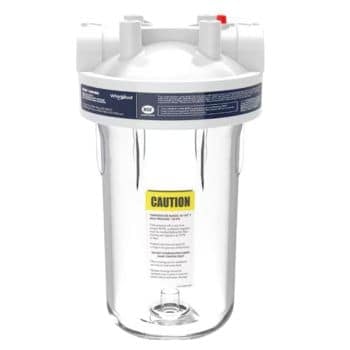
Scoring basis
- Filtration (50%): Score: 3.5/5 — Effective for sediment, rust, and silt
- not designed for dissolved iron, sulfur, or bacteria
- Flow/Pressure (15%): Score: 4/5 — Holds 8–10 GPM with coarse cartridges
- fine micron ratings drop pressure faster
- Install/Maint (10%): Score: 4.5/5 — Simple DIY install
- cartridges swap in minutes every 3–6 months
- Build (10%): Score: 4/5 — Clear sump aids monitoring
- NSF component certified
- durable but plastic prone to overtightening cracks
- Taste (5%) — Score: 3.5/5
- Cost (5%) — Score: 5/5
- Certs (5%) — Score: 4/5
Whirlpool’s WHKF-DWHBB is a straightforward, budget-friendly sediment filter housing designed for whole-house setups. It doesn’t “treat” water on its own, but paired with the right cartridge, it can catch sand, rust, and silt before they clog plumbing or downstream filters. Its clear sump is handy for quick visual checks, which is why many well owners start with this kind of setup.
What we like
- Clear housing makes it easy to see when cartridges need changing.
- Compatible with standard 10” x 4.5” cartridges — flexible and inexpensive to maintain.
- Compact and DIY-friendly design; installs easily in line as a pre-filter.
- NSF component certified for material safety.
What we don’t
- Housing alone doesn’t solve iron, sulfur, bacteria, or pH issues — cartridges must be carefully matched.
- Flow can bottleneck with fine-micron cartridges in larger homes.
- Plastic fittings are more prone to cracking if over-tightened compared to tank-style systems.
Best for: Budget-friendly sediment defense on wells — a simple first stage that keeps pipes and larger filters from clogging.
🧾 How the Whirlpool WHKF-DWHBB Scored
The WHKF-DWHBB is a cartridge housing rather than a full filter, so its effectiveness depends on the cartridge you install. With a 5-micron sediment cartridge, it reliably traps sand, silt, and rust before they reach plumbing or downstream systems — a key first step for many well owners.
Compared with tank systems like the SpringWell WS, it doesn’t tackle dissolved iron, sulfur odors, or manganese — contaminants that are common in well water. Against cartridge setups like the iSpring WGB32BM, it’s more limited since it holds just one cartridge, but it wins on simplicity and cost.
Annual upkeep is low, with cartridges running $15–$30 and needing replacement every 3–6 months. In our use, cartridges sometimes clogged faster than expected, which is one reason we’re running lab tests to see exactly how much sediment it removes and how quickly flow is impacted.
User insight: Many owners use this housing as a budget entry point into well filtration. It clears up cloudy water and protects appliances, but those with staining, odors, or metallic taste soon find they need to pair it with a larger system.
Bottom line: A budget-friendly sediment pre-filter that plays an important support role. Great for sand, silt, and rust, but not a complete fix for well water’s bigger challenges.
📘 Buyers Guide
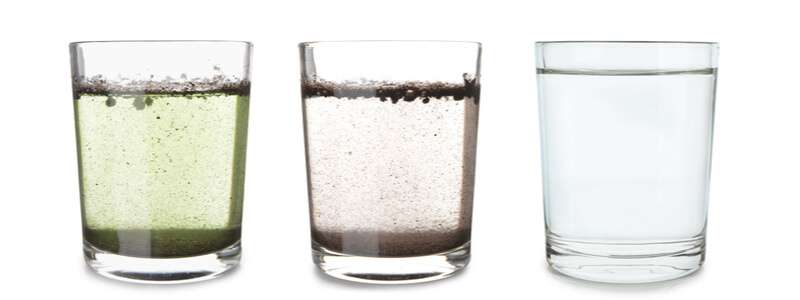
Over 60 million Americans rely on private wells — and many have no idea what’s flowing from their tap. Unlike city water, there’s no municipal monitoring. If your water smells off, leaves stains, or just tastes strange, it’s time to take control.
Even crystal-clear well water can carry invisible risks — from metals like lead or arsenic to bacteria and sulfur. That’s why testing isn’t just a suggestion — it’s step one.
🚨 What’s Lurking in Your Well?
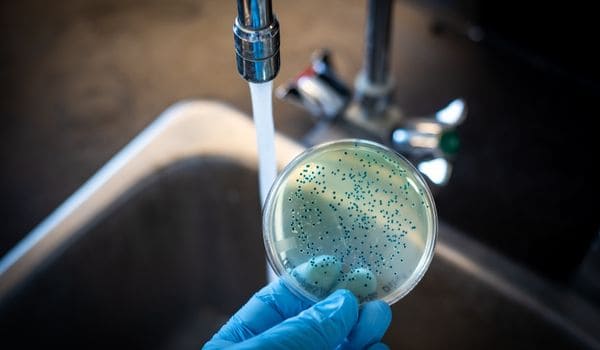
These common culprits are why filtration matters:
- Iron & Manganese – Cause rust stains, bitter metallic taste, and black sludge
- Sulfur – The infamous rotten egg odor
- Nitrates – Especially dangerous for infants and pregnant women
- Coliform Bacteria – Can indicate contamination from animal or human waste
- Lead, Arsenic & Radon – Naturally occurring but hazardous at high levels
- VOC’s & Pesticides – Common near farms or industrial areas
💡 Pro Tip: You don’t need to guess. A simple lab test will show you exactly what’s in your water — and help you choose the right filter.
🧲 Dealing with Iron in Well Water
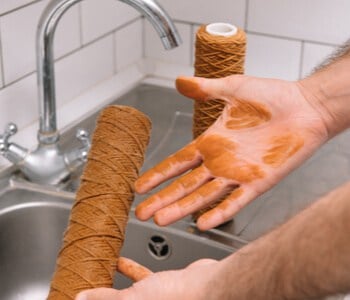
Excessive iron can lead to orange stains, bitter taste, and clogged pipes. It typically shows up as either ferric (visible) or ferrous (dissolved) iron. For light to moderate levels, a whole house iron filter with KDF or air injection is usually enough. For severe iron (5+ ppm), a dedicated oxidation-based system is your best bet.
🧠 Expert Insight: Always test for manganese too — it often travels with iron and requires a similar treatment approach.
🦨 Tackling Sulfur Odors (Rotten Egg Smell)
If your water smells like rotten eggs, it’s likely due to hydrogen sulfide gas. This can happen from decaying organic matter or sulfur-reducing bacteria in the well. A filter with air injection oxidation or KDF-85 media typically removes the odor effectively.
🔧 Troubleshooting Tip: If the smell is strongest in hot water only, the issue could be your water heater’s anode rod — not the well itself.
🦠 Coliform Bacteria in Well Water
Coliforms are bacteria that can sneak into your well through runoff or a cracked casing. While not always dangerous themselves, their presence may signal fecal contamination — especially E. coli. Most homes use a UV purifier after the sediment filter to neutralize bacteria without chemicals.
💡 Pro Tip: Shock chlorination can help with recurring coliform problems, but it’s not a long-term substitute for UV.
🧪 Arsenic & Other Heavy Metals
Naturally occurring in some groundwater, arsenic, radon, and lead can accumulate silently. These metals require either reverse osmosis (for drinking) or specialty media like activated alumina for whole-house removal. Standard carbon won’t cut it here.
💡 Lab Tip: If you’re in a high-risk area, use a lab test that specifies arsenic levels (both As(III) and As(V)) — they respond differently to filtration.
🧬 Nitrates, VOCs & Pesticides
Farms and industrial sites can contaminate wells with nitrates and volatile organic compounds (VOCs). Nitrates are especially risky for infants. Use reverse osmosis or ion exchange for nitrates, and catalytic carbon for VOCs and pesticides.
📋 Testing Note: If you’re near farmland, test for nitrates every year — especially if anyone in the home is pregnant or under 1 year old.
🍂 Trouble with Tannins? You’re Not Alone

Tannins are organic compounds found in decaying vegetation — often showing up in well water as yellow or tea-colored stains on laundry, sinks, and toilets.
They’re common in areas with lots of leaves or — peat-rich soil. The water may smell slightly earthy but isn’t usually harmful.
| 💡 Symptom | 🎯 Likely Cause | 🔧 Best Treatment |
|---|---|---|
| Yellow tint in water or laundry | Organic tannins from vegetation | Anion exchange system or specialty tannin filter |
| Musty or earthy odor | Decaying plant matter in groundwater | Oxidation + filtration combo |
| Dark stains on porcelain or grout | Tannins reacting with iron | Tannin filter with iron pre-treatment |
🧪 Lab Insight: Most water tests skip tannins. You’ll need to request a Total Organic Carbon (TOC) test or run a specialized colorimeter to confirm tannin levels.
🪨 Sediment & Turbidity

Sediment might not stain your sink like iron or tannins — but it can choke your flow rate, clog filters prematurely, and damage appliances.
The source depends on your aquifer: it could be sand, silt, clay, or even rust flakes.
| 🔍 What You See | 💥 Problem Behind It | 🛠 Recommended Filter |
|---|---|---|
| Cloudy water or grit in glass | Sand or coarse particles | Spin-down filter or sand separator |
| Brownish build-up in appliances | Silt or clay intrusion | 5–10 micron sediment cartridge |
| Rust-colored particles | Corroded well pipe or high iron | Sediment pre-filter + iron filter |
🧰 System Insight: Spin-down filters are great for large particles but won’t catch fine silt — you’ll need a staged cartridge setup for that.
🔬 Why Well Water Testing Comes First
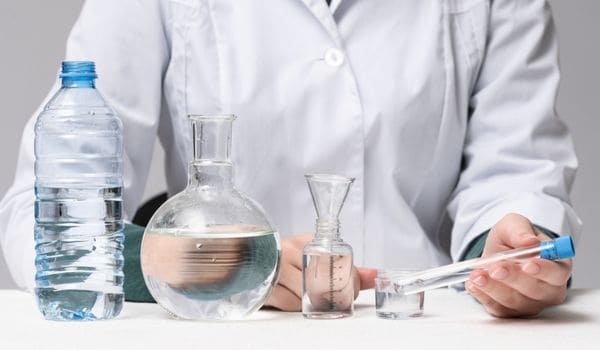
Even if your water looks crystal clear, it could be hiding serious issues — like lead, bacteria, or arsenic. And here’s the thing: no filter works unless it’s solving the right problem.
💧 Start with a water test — it’s the only way to know what you’re actually drinking.
There are two ways to test:
- 🧪 Lab Testing – The gold standard. Accurate, detailed results with specific contaminant levels.
- 🏠 At-Home Kits – Good for quick checks (like pH, hardness, and iron), but limited for things like lead or bacteria.
💡 Pro Tip: If your water smells weird, stains your sink, or tastes metallic — don’t guess. Test it. It’ll save you time, money, and regret.
🧭 How To Choose the Right Filter (Without Guesswork)

Now that you know your options, let’s make sense of what actually works for your water. Here’s how to narrow it down:
| 🚩 Water Issue | What to Look For |
|---|---|
| Iron (orange stains, metallic taste) | 🟢 Air Injection or Katalox-based systems — skip carbon-only units |
| Sulfur smell (rotten eggs) | 💨 Look for oxidation + media like greensand or hydrogen peroxide injection |
| Manganese (black slime) | 🧪 Oxidizing filters with strong backwashing — not cartridges |
| Coliform or E. coli bacteria | 💡 Add UV or chlorination — filters alone won’t solve it |
| Heavy metals (like lead or arsenic) | ⚙️ Use reverse osmosis or KDF — test levels first |
| Low pH (acidic water, blue-green stains) | 🧱 A calcite pH neutralizer helps protect your plumbing |
| Cloudiness or sediment | 🔎 Install a sediment pre-filter (5 micron or less) |
| “Flat” or chemical taste | 🥤 Carbon block filters improve taste & odor |
💡 Pro Tip: You might need a combo system — like an iron filter with a UV add-on, or a softener plus reverse osmosis. Layering filters = better results.
📏 Sizing Your System Right (Capacity, Flow & Microns)
A well filter isn’t one-size-fits-all. The right fit depends on how much water your home uses — and what kind of particles you’re trying to stop.
| 📊 Factor | What To Know |
|---|---|
| 💧 Flow Rate (GPM) | Check how many gallons per minute your home uses — 6–12 GPM is typical. A bucket test can help you calculate this quickly. |
| 🧪 Micron Rating | Lower = finer filtration. 5 microns stops sediment and rust. 0.01–0.0001 microns (RO) tackles fluoride, arsenic, and viruses. |
| 📦 Total Capacity | Look for systems rated 500k–1M gallons if you want fewer filter changes and better long-term value. |
🔧 Pro Tip: If your shower pressure drops when someone runs the dishwasher, it’s probably a flow rate issue — not just your pump.
🏅 What Really Matters? Certifications & Support
Not all filters are created equal — and flashy marketing isn’t the same as proof. That’s where third-party testing and real customer service come in.
| ✅ Certification | What It Verifies |
|---|---|
| 🔵 NSF/ANSI 53 | Removes health-related contaminants like lead, VOCs, nitrates, and pesticides. |
| 🧪 NSF/ANSI 42 | Improves taste, smell, and clarity by reducing chlorine, particulates, and odor. |
| 🔐 NSF/ANSI 61 | Confirms filter components won’t leach unsafe materials into your water. |
| 🏅 WQA Gold Seal | Verifies structural integrity, performance, and manufacturer accountability. |
🛠️ Good to Know: Companies that offer long warranties, free support, and detailed manuals are usually the ones that stand behind their product — and make your life easier after the install.
🧪 What Type of Filter Do You Actually Need?
Not all well water problems need the same fix. Here’s how the most common filter types compare — and where they shine:
| 🔍 Filter Type | What It’s Good At |
|---|---|
| 🌬️ Air Injection (AIO) | Tackles iron, manganese, and sulfur by oxidizing them into filterable solids — great for smelly or rusty water. |
| 🧊 Carbon Block | Polishes taste and smell by absorbing chlorine byproducts, pesticides, and other chemical runoff. |
| 🧪 KDF Media | Reduces heavy metals like lead and mercury — often used as a pre-filter with carbon for stronger defense. |
| ☢️ UV Light | Destroys bacteria, viruses, and other microorganisms — perfect if coliform or E. coli are detected. |
| 🧱 Sediment Filter | Catches sand, rust, and grit that clog plumbing and damage other filters. A must-have first stage for wells. |
⚠️ Heads Up: Just because your water looks clean doesn’t mean it’s safe. The best setup often combines multiple filter types to catch everything from sediment to sulfur.
🪣 How to Check Your Well Flow Rate (No Math Required)
Before picking a filter, you’ll want to know how much water your system can push. A slow well may not keep up with high-flow systems.
Here’s an easy test:
- Make sure no one is using water inside your home.
- Grab a 5-gallon bucket and time how long it takes to fill from a spigot near your pressure tank.
- Match your time to the table below:
| ⏱️ Time (Seconds) | Estimated GPM |
|---|---|
| 75–100 sec | 3 GPM |
| 60–74 sec | 4 GPM |
| 50–59 sec | 5 GPM |
| 38–49 sec | 6–7 GPM |
| 30–37 sec | 8–9 GPM |
| Under 30 sec | 10+ GPM |
💡 Pro Tip: If your GPM is under 6, avoid backwashing systems unless you install a storage tank or booster pump.
💸 Installation & Maintenance Costs (What to Expect)

Whole house filters aren’t cheap — but the wrong one can cost even more over time. Here’s what to plan for:
| 🛠️ System Type | Typical Install Cost | Annual Upkeep |
|---|---|---|
| Iron / Sulfur Filter (tank-based) | $500–$1,200 | $50–$150 |
| Cartridge System (3-stage) | $300–$800 | $150–$350 |
| Reverse Osmosis (whole home) | $800–$1,500 | $200–$300 |
| UV Disinfection | $350–$600 | $75–$200 |
| Calcite pH Neutralizer | $500–$900 | $100–$200 |
🔍 Watch Out: Some systems look cheap upfront but require constant cartridge swaps or proprietary filters that add up fast.
✅ Smart Move: Prioritize filters with longer-lasting media (like AIO tanks or KDF/carbon combos) to save money long-term.
🧯 Troubleshooting Specific Well Water Issues

Some well water problems need targeted fixes — a general filter won’t cut it. Here’s how to match the right tech to the job:
| 🚩 Problem | ✅ Best Solution |
|---|---|
| High Iron (orange stains, metallic taste) | Air injection + sediment pre-filter |
| Rotten egg odor (Hydrogen sulfide) | Oxidation filter with greensand or peroxide system |
| Coliform or E. coli | UV treatment or chlorination system |
| Acidic water (low pH, blue/green stains) | Calcite pH neutralizer |
| Arsenic | RO system with alumina cartridge or point-of-use filter |
| Lead & heavy metals | KDF media + carbon filter or RO at the tap |
🔧 Good to Know: If your water has multiple issues — like iron and bacteria — you’ll likely need a layered solution (e.g., AIO + UV).
⚖️ Whole House Filter Pros & Cons (The Honest Tradeoffs)

Installing a whole home filter is one of the smartest moves for well owners — but it’s not all plug-and-play. These systems can seriously upgrade your water quality — but.. they’re not perfect. Some tradeoffs are worth it, and others… not so much.
Let’s take a quick, honest look at both sides:
| 👍 Pros | 👎 Cons |
|---|---|
| ✅ Filters all water entering your home — not just one tap | ⚠️ Upfront cost can range from $500 to $2,500+ |
| ✅ Reduces odors, stains, and health risks in one solution | 🔧 Most systems need pro installation or serious DIY skills |
| ✅ Removes contaminants you can’t see or taste | 💸 Annual maintenance costs can add up (filters, salt, peroxide) |
| ✅ Improves appliance life by reducing buildup & corrosion | 🧪 Requires testing to match the right system to your water |
| ✅ Can be paired with add-ons like UV or RO for full coverage | 📏 Choosing the wrong size or filter type can lead to poor results |
💡 Bottom line: Whole house filters are one of the best long-term moves for well owners — but only if you size them right and know what you’re up against. Test first, then filter smart.
🛡️ Filter Warranties & Money-Back Guarantees
Before you drop four figures on a whole house filter, it’s worth knowing who actually stands behind their product — and for how long. Here’s how the most trusted brands compare:
| 🔧 Brand | Warranty | Money-Back Guarantee |
|---|---|---|
| SpringWell | Lifetime | 6 months |
| Aquasana | 6 years | 90 days |
| Pentair | 5 years | 60 days |
| iSpring | 1 year | 30 days |
💡 Pro Tip: Be sure to check the fine print — some warranties don’t cover tanks or electronics. Always read the service terms before buying.
🧪 Still Not Sure Which Filter You Need?
The smartest move is to start with a water test. It’ll show you exactly what you’re dealing with — from common issues like: iron or sulfur to more serious concerns like bacteria or heavy metals.
Once you have the results, matching the right system becomes a whole lot easier — and a lot less stressful.
✅ A good test takes out the guesswork so you can filter with confidence.
⚠️ What NOT to Do When Buying a Well Water Filter
Even smart buyers make mistakes. These are the most common regrets we see — and how to avoid them:
- ❌ Skipping the water test You’ll likely waste money on a filter that doesn’t solve your actual issue.
- ❌ Choosing the cheapest system Some look like a steal — until you’re swapping filters every month.
- ❌ Buying a system that’s too small If your GPM rating is off, get ready for weak showers and slow fill times.
- ❌ Thinking “one filter fits all” Most well systems need a combo setup — like iron + UV, or RO + softener.
- ❌ Forgetting maintenance If the system has proprietary cartridges or hard-to-find parts, skip it.
💡 Pro Tip: Choosing a well water filter doesn’t have to feel risky — just stay focused on your test results, your flow rate, and your future maintenance. When in doubt, start simple and scale up. It’s easier (and cheaper) to layer solutions than undo a bad one.
🏁 Final Thoughts
Owning a well puts you in charge — but it also means the safety of your water is entirely up to you. The good news? You’ve already done the hardest part: figuring out what to look for.
Whether you’re fighting off rust stains, sulfur smells, or something more serious, there is a system that can fix it. And now, you’ve got the knowledge to choose one that actually works — not just one that looks good in a spec sheet.
💡 Pro Tip: Still unsure? Start with a water test. It’s the best way to avoid guessing — and it makes filter shopping a whole lot easier.
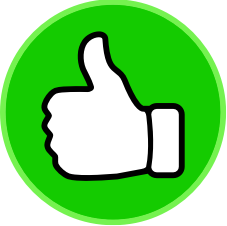 110 people found this helpful. Was this guide helpful to you?
110 people found this helpful. Was this guide helpful to you? 

